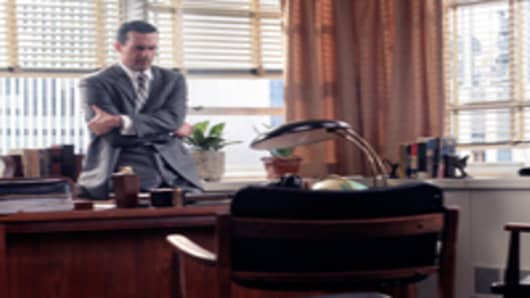Yours truly can’t be the only “Mad Men” viewer to get envious every time an employee of Sterling Cooper enters his personal office, then closes the door, free to concentrate in silence or even take an emergency catnap.
A private office is so dignified, so peaceful—and much like a 1960s ad exec’s ashtray stand and desk-side minibar cart, it’s increasingly becoming a relic of the past.
This isn’t only the case for administrative employees or call center workers. Open plans are being introduced in offices of professions like law and medicine. Franklin Becker, director of International Workplace Studies Program at Cornell, mentions a colleague’s organization in California that wants to put new doctors in an open-plan environment.
“That’s a different sell when you’re trying to attract doctors who are in short supply and have a lot of choices [of where to work],” he said, “but I’ve seen it work in Australia.”
One major motivation to do this, of course, is to cut costs: With cubicles and open workstations, more employees fit into less space. “You really couldn’t put a person into a 6-by-8 closed office very comfortably,” Becker said. "We would call it like a prison cell. But we easily sit in 6 by 8, 6 by 6, or a 6-by-4-foot desk in an open-plan environment. You can reduce the amount of space you need substantially.”
Since the 1970s and '80s, office layouts have been shifting to open-plan models that include more co-working spaces, with less emphasis on private individual offices. The changes accelerated during the dot-com boom and more recently with the nontraditional workplaces of technology startups. The most recent data available from the International Facility Management Association puts the percentage of open-office/bullpen environments at 68 percent. In addition, the average amount of space per employee (such as workstation and meeting rooms) in the U.S. has dropped by over a third since 1985, from 400 square feet to 250 square feet, according to 2011 data from the commercial real estate services firm Jones Lang LaSalle.
Other reasons for the layout shift are that an open-plan environment provides more opportunities for collaboration (both planned and spontaneous), and more of a sense of community among employees. One study in the Harvard Business Review found an enormous increase in workplace productivity: “Companies that encourage collaboration by switching from closed-offices to open-offices realize performance increases (speed and accuracy of work) by 440%.”
Such changes to office layouts must be carefully planned and done for the right reasons to be effective, but often they are not, said Arnold Levin, workplace strategy director for NBBJ, an architecture, planning and design firm.
“Shifting employees from closed or private space to open space will only work if the need for privacy is recognized and accommodated for as well,” Levin said. “This can be handled by providing what is often referred to as ‘short-stay rooms’ or telephone rooms. They are usually small one- and two- person private rooms where a worker can make a private call, engage in a conference call so as not to disturb neighbors, or do heads-down work where one requires privacy. These spaces are usually not dedicated to an individual and are not to be occupied for more than half a day at a time.”
Not all workers can thrive in an open plan, which is likely to have more disruptions. Levin cites the example of his daughter, who is dyslexic, who will need an environment that fosters concentration when she enters the work world.
“That’s the key when these [changes] are done right,” said Becker. “You provide a whole system of space, rather than all open or all closed off.”
All the planning of new office plans won’t do much good if the employees don’t take full advantage of the spaces. When introducing a more open office plan to employees, it’s also important to incorporate a change management program, Levin says. Someone in the office should understand the reasons for the layout choices and its benefits, so they can properly introduce them to the team.



